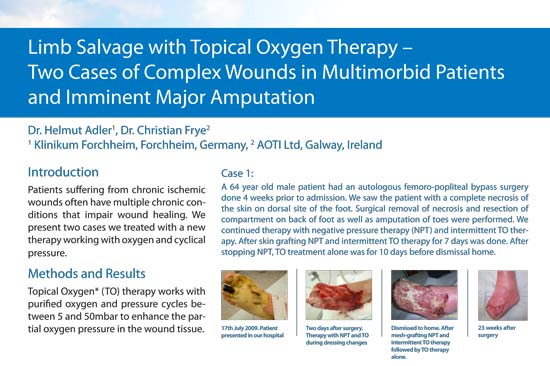Limb Salvage with Topical Wound Oxygen (TWO2) – Two Cases of Complex Wounds in Multimorbid Patients and Imminent Major Amputation
Dr. Helmut Adler1, Dr. Christian Frye2
1 Klinikum Forchheim, Forchheim, Germany, 2 AOTI Ltd, Galway, Ireland
Introduction
Patients suffering from chronic ischemic wounds often have multiple chronic con- ditions that impair wound healing. We present two cases we treated with a new therapy working with oxygen and cyclical pressure.
Methods and Results
Topical Oxygen* (TO) therapy works with purified oxygen and pressure cycles be- tween 5 and 50mbar to enhance the partial oxygen pressure in the wound tissue.
Case 1:
A 64 year old male patient had an autologous femoro-popliteal bypass surgery done 4 weeks prior to admission. We saw the patient with a complete necrosis of the skin on dorsal site of the foot. Surgical removal of necrosis and resection of compartment on back of foot as well as amputation of toes were performed. We continued therapy with negative pressure therapy (NPT) and intermittent TO ther- apy. After skin grafting NPT and intermittent TO therapy for 7 days was done. After stopping NPT, TO treatment alone was for 10 days before dismissal home.
Case 2:
72 year old male diabetic patient with AVK developed a gangrenous forefoot. Prior to admission to surgical ward therapy with prostavasin was done. There were no possibilities to improve arterial vascular status via surgical procedures. A transmetatarsal amputation with repeated debridement was performed followed by negative pres- sure therapy and resection of necrotic tis- sue. After 6 weeks of no further improve- ments we started with TO for 6 days. The wound granulated well and we decided to skin graft followed by negative pressure and TO therapy on days of dressing chang- es for 6 days. After 13 days of solely TO the wound granulated well and the patient was dismissed to rehabilitation.
Conclusion
In these two complicated cases both associated with severe co morbidities TO proved to be an valuable adjunctive therapy with good results in healing and more important to maintain the functional status by avoiding major amputation.

